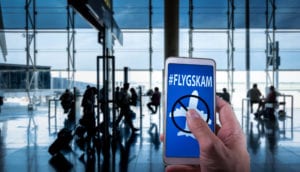
By Julien Etchanchu, Managing Consultant
With climate scientists delivering increasingly doom-laden forecasts of where the world is heading, sustainability has become a hot topic in the business travel industry. And while it is important for everyone on both the supplier and traveler sides to play a role, airlines are currently under the spotlight when it comes to developing sustainable travel initiatives.
In the first of a two-part series, we examine the current context for sustainable air travel and some steps that airlines are currently taking to address this issue. In part two, we’ll look at the four steps that travel managers can take to make their programs more sustainable and help meet organizational goals.
Sustainability – Why Should We Care?
So, why should the business travel world care about sustainability? Scientists around the world have been creating forecasts to map the possible effects of climate change for the past several decades, and one thing is clear – we must reduce our impact on the environment or face serious consequences ranging from melting polar ice and rising sea levels, to desertification and forest fires.
The age groups that will be affected by these changes, in particular 18 to 35-year-olds, have made sustainability an important part of their lives – from their personal choices to what they expect from corporates and brands. Over the next few years, this age group will make up an even larger share of the global workforce. A recent UK survey showed that almost one third of this age group are worried about climate change, compared to only one fifth of people over 65.
Even outside of that age group, there are indications that environmental issues are becoming a major concern. Across Europe, Green parties have started to win seats, evolving from a fringe element of the political landscape to a more influential force. This indicates that sustainability and climate-related issues are becoming more important to everyone around the world. Other research supports this idea. A recent global study by the European Investment Bank shows that 63% of Americans, 65% of Chinese, and 78% of Europeans are concerned or alarmed about climate change.
Airlines – an Increasing Share of CO2 Emissions
One of the industries that is in the spotlight as people begin to focus more on climate change is air travel. That’s because it currently represents 2.5% of CO2 emissions worldwide. Many estimate that by 2050, the airline industry could take up to 25% of the global carbon budget.
The reason for this is that the tourism sector is booming, and low-cost airlines have made air travel more affordable than ever before. And despite the use of more efficient aircraft, the number of passengers is rising. Airlines have significantly increased their fuel efficiency over the last two decades (50% vs 1990), but this hasn’t been able to keep up with the booming demand for air travel. As a result, net emissions are constantly increasing. As other industries successfully decrease emissions, the relative share of the CO2 budget contributed by airlines is on the rise. So, there’s a big gap between fuel efficiency and fuel emissions, leading to very different communications from both airlines and climate scientists.
In addition, IATA has set very ambitious goals: to achieve carbon-neutral growth by 2020 and reduce net emissions by 50% in 2050 vs 2005.
“Flygskam” and the Thunberg Effect
Climate change issues have recently been pushed to the forefront global headlines thanks to the school strikes inspired by Swedish climate activist Greta Thunberg. Her international speeches and actions, together with indications that the pace of climate change is speeding up, have started to make people more aware of their own individual travel footprints. And these footprints are not small. For example, the annual climate budget per person is set at 2.3 tons of CO2. A single return flight from Frankfurt to Singapore in business class uses 6.5 tons of CO2.

This awareness of the lack of sustainability of air travel is already having an effect. In Sweden, there is a new word: “flygskam” or flying shame. This is the shame of using transport that relies on fossil fuels. Swedish domestic travel air passenger numbers have experienced a decline for several consecutive months, and a 3% fall in 2018 overall. Meanwhile the Swedish train operator has seen numbers increase. SAS CEO Rickard Gustafson says it’s clear that airlines must address climate change and become more sustainable until the world no longer relies on fossil fuels.
How Airlines Are Working on Increased Sustainability
Several airlines around the world have implemented initiatives to make air travel more sustainable. While these aren’t yet standard across the board, it’s an indication of how air travel could be improved in the next few years.
Here are some examples of what airlines are currently doing:
Boost Fleet Efficiency
The most important leverage that airlines have is to make their fleet more efficient. This is a matter of replacing inefficient aircraft with those designed to reduce emissions. For example, the A320 Neo produces 20% less CO2 emissions than its predecessor, and this aircraft is already used by a number of air carriers around the world.
SAS CEO Rickard Gustafson believes that within the next 20 years, there’ll be more improvements to jet engines, reducing emissions even further. And the ICAO is predicting that aircraft will get lighter, quieter and more efficient.

Use Biofuel Instead of Fossil Fuel
Rather than using fossil fuel, airlines can use biofuel – but only if it comes from a sustainable source. Sustainable biofuel can be derived from plants, algae or industrial waste and is considered a renewable resource. There are biofuels that are not considered sustainable, one example is palm oil, which has led to devastation in the Indonesian rain forests. KLM has a corporate biofuel program and aims to reduce CO2 emissions by 20% by 2020. However, the supply of sustainable biofuel remains an issue. In Sweden, SAS is working with local refinery, Preem to increase production so it can use biofuel for all domestic consumption by 2030.
Optimize Air Traffic Control
Improvements to piloting and air traffic control are other ways that air travel can become more sustainable. In a Euractiv report on Greening Aviation, Boeing’s Antonio de Palmas suggested that modernizing air traffic control could help reduce delays, streamline flights, optimize takeoffs and landings and use more fuel-efficient routes.
Improve Onboard Sustainability
Onboard sustainability is another aspect of making airlines more eco-friendly overall. Waste reduction and recycling are two aspects of this strategy. By 2020, Air Alaska aims to reduce inflight waste by 70% over the 2010 baseline. As part of that initiatives, it’s reduced packaging on inflight meals and is collecting and recycling recyclable cups, bottles, paper and plastic from passengers. Meanwhile, Air France is eliminating single-use plastic from its flights.
Use Electric Vehicles
Of course, planes are not the only issue when talking about sustainable air travel. Airports have whole fleets of vehicles to service planes, transport inflight meals and luggage, and do other necessary tasks. Some airports (for example, Munich Airport and Malaysia Airports) are addressing this by converting their fleets to electric vehicles.
Increase Air/Rail Collaborations
Finally, there’s been an increase in collaborations between airlines and train service providers. This allows business travelers who must take long haul flights to do the domestic portion of their travel by train, before taking a plane – reducing CO2 emissions for the trip as a whole. This is already happening in Germany with Lufthansa and Deutsche Bahn, and in France with Air France and SNCF.
In part two of this series, we’ll look at four steps that travel managers can take to make their corporate travel programs more sustainable and how they communicate these initiatives to their travelers.
View our latest press release on Sustainable Collaboration here.
